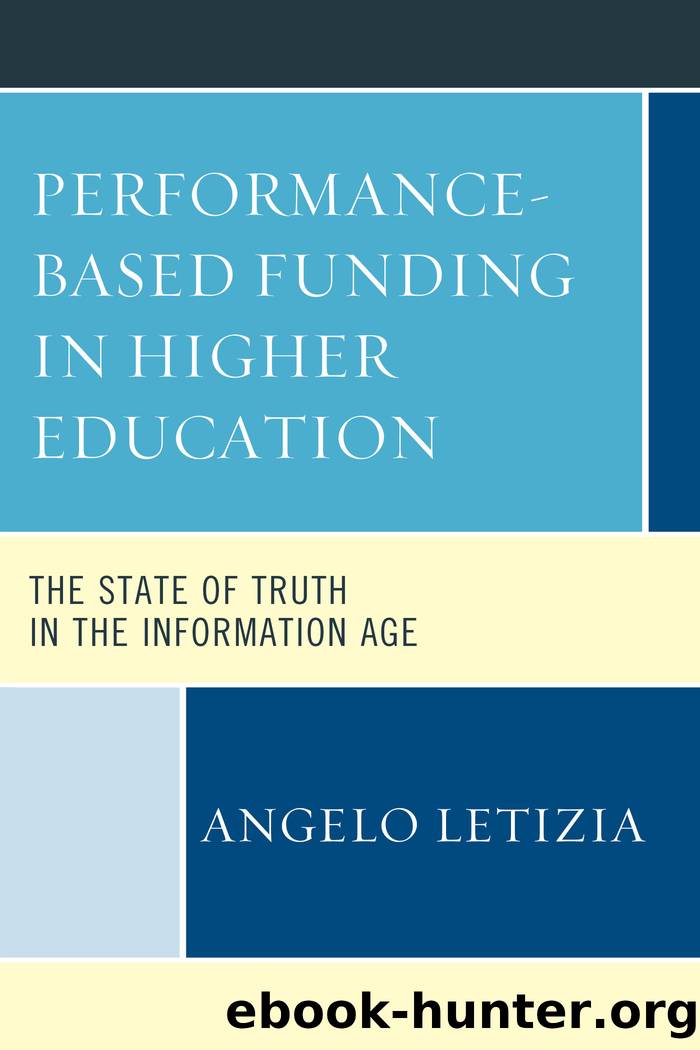Performance-Based Funding in Higher Education by Letizia Angelo;

Author:Letizia, Angelo;
Language: eng
Format: epub
Tags: undefined
Publisher: Lexington Books
Published: 2012-08-15T00:00:00+00:00
What is the Public Good?
The reliance on the crude delineations between public and private institutions, as well as the reliance on the traditional borders of nation-states, may need to be rethought in the information age and specifically for truth creation, when technology and communication are rapidly bringing humanity in connection with each other (Marginson, 2007; Singer, 2004). Truth cannot be bounded and boxed in by these arbitrary and increasingly restrictive boundaries. The purpose of higher education institutions is to promote the public good. As elucidated by authors Calhoun (1998) and Mansbridge (1998), the public good refers to the access and distribution of public programs such as, education, and healthcare. Other indicators of an actualized public good include: a fair legal system, societal participation in the development of public policy, and access to socioeconomic mobility (Marginson, 2007; Pusser, 2006). Higher education institutions support all of the aforementioned components of the public good and have traditionally been regarded by policymakers to create a vibrant vision of the public good in their states (Zumeta, 2011).
The benefits that accrue to a society due to the presence of higher education institutions are classified in four distinct ways; social monetary benefits, social nonmonetary benefits, individual monetary benefits, and individual nonmonetary benefits. There is also crossover between these benefits and they are not mutually exclusive. General happiness (which is not referenced in either policy), as measured by reliable psychological tests on samples of the population indicate, is an example of a social non-monetary benefit. A multitude of research indicates that graduates of four-year schools tend to score higher on happiness index measures. General happiness cannot exist without individual happiness, so happiness can be measured as individual or social. Along with happiness, general health is also increased as a result of higher education. Individuals who obtain a four-year degree are likely to have fewer health problems, as are their children. Health can be measured as social or individual nonmonetary benefit, but it can also be measured as a social and individual monetary benefit in the shape of health costs. Health is also linked to happiness. The fine arts and liberal arts have been shown to foster toleration, critical viewpoints, and diversity, which can be classified as individual and social nonmonetary benefits.
Many of these phenomena can be considered externalities. An externality is usually defined as an unintended benefit that accrues to individuals and to society as a whole (Greenwood, 1997; McMahon, 2009). One of the greatest externalities of higher education is the intergenerational benefit to the children of parents with a higher education (Bowen, 1996; McMahon, 2009). Health, happiness, literacy, and general academic achievement are all increased in children whose parents have a degree (Bowen, 1996). Happiness, health, art, literature, and externalities in general illustrate the complex nature of higher education, and how higher education can be understood as a complex constellation of interrelated phenomena.
Yet, the notion of the public good may have to be expanded drastically in the information age. It may make more sense to understand the public good as a global public good.
Download
This site does not store any files on its server. We only index and link to content provided by other sites. Please contact the content providers to delete copyright contents if any and email us, we'll remove relevant links or contents immediately.
The Art of Coaching Workbook by Elena Aguilar(50167)
Trainspotting by Irvine Welsh(21077)
Twilight of the Idols With the Antichrist and Ecce Homo by Friedrich Nietzsche(18324)
The Secret History by Donna Tartt(18266)
All the Missing Girls by Megan Miranda(14852)
Cat's cradle by Kurt Vonnegut(14804)
Ready Player One by Cline Ernest(14061)
Talking to Strangers by Malcolm Gladwell(12916)
Fangirl by Rainbow Rowell(8819)
The Compound Effect by Darren Hardy(8543)
Thirteen Reasons Why by Jay Asher(8490)
The remains of the day by Kazuo Ishiguro(8432)
Periodization Training for Sports by Tudor Bompa(7946)
Tools of Titans by Timothy Ferriss(7850)
Wonder by R. J. Palacio(7755)
The Lover by Duras Marguerite(7603)
Change Your Questions, Change Your Life by Marilee Adams(7405)
A Court of Wings and Ruin by Sarah J. Maas(7305)
The Complete Stick Figure Physics Tutorials by Allen Sarah(7162)
